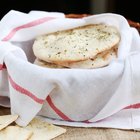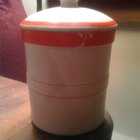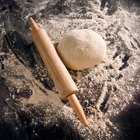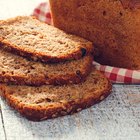AlexPro9500/iStock/GettyImages
According to the French law Décret Pain, real French bread can only be made with the basic four ingredients of wheat flour, water, salt and yeast. The absence of oil makes for a lean dough and a crusty loaf designed to be eaten within the day. French bread is best enjoyed while still warm from the oven or bakery, although a few storage tips and method variations can help preserve your homemade French bread a bit longer.
Process of Staling
Bread goes stale when it loses moisture. During baking, steam allows the starch molecules to weaken, swell and soften your bread’s interior. Once out of the oven, the process created by the steam begins to reverse. As the water dries up, the starch molecules harden, and so does your bread. The presence of oil in bread helps to keep the moisture trapped inside. Because French bread contains no oil, it loses moisture more rapidly than other breads made with fat. While it might seem like a good idea to store your French bread in the refrigerator to keep it soft, doing so dries it out faster.
Tricks for Storing
In the old days of bread making, the hard, outer crust of bread served as its only means of preservation. Today, we have another option. You can save your French bread for another day by storing it in the freezer. Place your bread in a freezer bag, and draw out any extra air through a straw; alternatively, use an air-tight container. When you remove it, your loaf should thaw out in three hours or less, depending on the shape. It can also be thawed in the microwave in just a few seconds, but wrap it in a paper towel first to keep in the moisture.
Longer-Lasting French Bread
French breads such as baguettes made with a preferment or a starter -- also known as a poolish – don’t go stale as quickly as breads made without a starter. When the dough is allowed to ferment for a day or more, beneficial enzymes form. These enzymes add flavor and naturally preserve the bread, also making it resistant to molds. Breads made with a starter and whole-wheat flour stay moist even longer, because the whole bran of wheat takes longer to dry out than processed wheat. Diastatic malt powder is another baker’s secret sometimes added to bakery bread that helps preserve the bread and make it last longer.
Uses for Stale Bread
Many recipes and uses have been developed for stale bread, so you never have to throw any of it away. Stuffing, croutons and bread puddings are perfect for day-old bread; Italian soup recipes such as pappa al pomodoro were specifically designed to take advantage of stale bread. Using bread just before it goes stale in grilled cheese or other hot sandwiches makes the bread taste fresh again. Slicing stale bread and sipping it into an egg batter to make French toast is perhaps the most popular way to use day-old French bread.
Related Articles
How to Keep Crusty Italian Bread Soft

How to Store Fresh Baked Bread

How to Make Egyptian Bread the Egyptian ...

How to Keep Sandwich Bread Fresh All ...

Does Bread Expire?
How to Make Bread That Does Not Crumble ...

What to Do With Pizza Dough When You're ...
Quick and Easy French Bread Recipe

How to Freeze Brioche

How to Make a Bread Starter
Secret to Making Soft Chewy Italian ...

Does It Matter if I Substitute Baking ...

How to Make Bread Chewy

Can I Make Chapati Dough in Advance?

Can You Refrigerate Homemade Yeast ...

How to Preserve Dough That Has Risen
How to Keep Indian Fry Bread Fresh

Does Yeast Cause Holes in Bread?

How to Make Cornbread in a Cast-Iron ...

How to Keep Homemade Bread from ...
References
Resources
Writer Bio
For more than 10 years, Carol Butler has run a small, off-grid furniture business with her husband and is a regular contributor to the Edible community of magazines. As staff writer for RichLife Advisors, she covers financial planning and other industry-related topics. She holds a B.F.A. in theater arts.